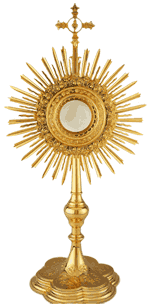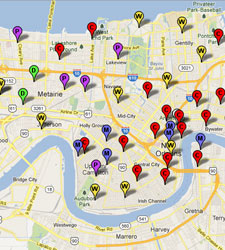As they approached the village to which they were going, he gave the impression that he was going on farther. But they urged him, “Stay with us, for it is nearly evening and the day is almost over.”
So he went in to stay with them. And it happened that, while he was with them at table, he took bread, said the blessing, broke it, and gave it to them. With that their eyes were opened and they recognized him.” (Lk 24:28-31a)
On June 10, 2004 while celebrating the Mass of the Solemnity of the Body and Blood of Christ at the Basilica of St. John Lateran, Blessed John Paul II announced that the year from October 2004–2005 would be a special “Year of the Eucharist.” Four months later, on October 7, 2004, the Holy Father issued the Apostolic Letter, Mane Nobiscum Domine, declaring the special year and outlining its purpose.
The Latin title Mane nobiscum Domine translates “remain with us, Lord,” and recalls the words spoken by the disciples on the road to Emmaus as they entreated the Lord, hidden in the person of a traveler, to remain with them. The image of these disciples on the way to Emmaus served as a fitting guide for a year when the Church was particularly engaged in living the mystery of the Holy Eucharist.
During life’s trials and tribulations, and even our bitter disappointments, the Divine Traveler continues to walk at our side, opening the Scriptures to us and leading us to a deeper understanding of the mysteries of God. He desires to be with us not only in eternity but especially today as we respond to the fulfillment of his promise to “be with us always, to the end of the age” (Mt 28:20).
Amid the darkness of the evening after the Crucifixion, the traveler brought a ray of light that rekindled the hope of the Emmaus disciples, and led their hearts to yearn for the Divine Light itself. “Remain with us,” they pleaded. And the traveler agreed. And soon afterwards, the face of Christ would disappear; yet the Master would “remain” with them, hidden in the “breaking of the bread” which had opened their eyes to recognize him.
As we approach the upcoming Solemnity of the Body and Blood of Christ, we are called to spend some time contemplating the two travelers on the road to Emmaus. Their journey from disappointment (Penitential Rite), to understanding God’s word (Liturgy of the Word), to seeing Jesus in the breaking of the bread (Liturgy of the Eucharist) to going out and proclaiming that He is alive (Dismissal) is the journey we follow each time we attend Mass.
Rev. Msgr. Christopher H. Nalty
msgr.nalty@gmail.com




